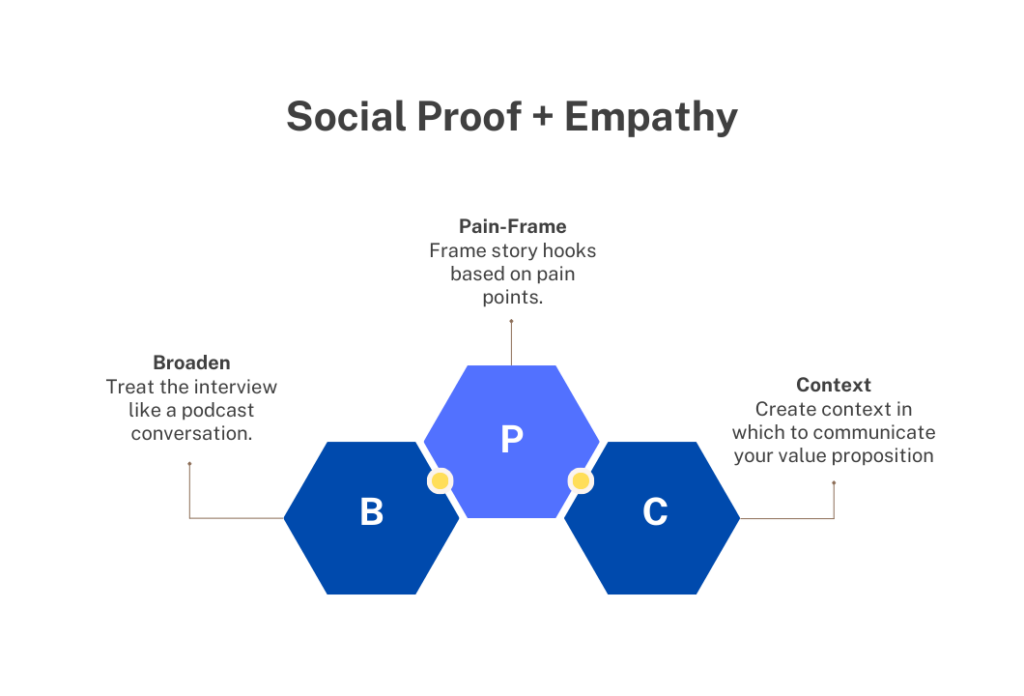
Customer stories have one thing a testimonial doesn’t.
But most marketers miss it because they only care about social proof.
The one thing: Empathy.
The Problem with Social Proof
When your sole focus in creating customer stories is to build social proof, the only thing that amplifies them are:
- The number of stories you have published
- The recognizability of your customer’s brand
You end up fighting for approval from big brands or on a hamster wheel of creation. Or both. 😐
But the point of a customer story is to build credibility. And social proof isn’t the only way to do that.
You can also do it with empathy—showing your audience you understand their problems better than anyone else.
This amplifies your stories because it gives marketers and salespeople more fresh, effective ways to share the story on social media, via email, and even in person.
Instead of this:
Customer X Increased Metric Y by Z% > Read the Story.
You can write hooks like this:
(P.S. These hooks all came from the same story)
Hook #1
In 2023, Avery Gold answered ANOTHER call from a frustrated prospect.
The prospect couldn’t schedule a showing. So Avery walked him through it. The prospect gave up anyway.
Avery was frustrated. So she decided to fix it.
Today, she’s booking 50% more showings, rarely fields a complaint, and no, she didn’t add headcount.
Here’s the story of how she did it:
Hook #2
Persuading your boss to switch to a new leasing system is hard.
The boss doesn’t feel the pain. They don’t answer the frustrated calls.
As the leasing manager, Avery Gold felt it.
Every day she talked prospects through scheduling a showing, accessing the property, submitting an application.
But she had better things to do.
She found a way to show her boss that the pain of switching was nothing compared to the promise of transforming their leasing process.
Here’s how she did it:
Hook #3
Avery Gold struggled to get her clients to see the light.
They didn’t want to reduce their rents. And nothing she said could convince them otherwise.
She’d have to wait until listings lingered on the market. Until it was painfully obvious. But by then, thousands of dollars were left on the table.
So she created a system for collecting data, soliciting prospect feedback, generating reports, and communicating with owners.
These days, things are different. Her clients are listening.
Read her story to learn more:
So how do you use your customer stories to show your customers you “get” them?
Shift Your Interviewing Paradigm
Step #1 is to change the way you think about customer interviews.
Typically, customer interviewers approach the conversation from the lens of challenge—solution—results.
They ask things like:
→ Before {{product}}, where did you turn to for {{challenge}}? ← Challenge
→ Why did you choose {{product}} over the alternatives? ← Solution
→ What were the results of using {{product}}? ← Results
But these questions create a conversation that’s ONLY about your product.
You should also ask things like:
→ What drives you nuts about how people do [insert activity] in [industry]?
→ Many people in [your role] in [your industry] have trouble doing [common challenge]. What’s your approach?
→ What role do you see [technology/trend] playing in [industry] for the next 5 years?
The answers may not always lead back to your product, at least not directly.
But more often than not the things that people strongly dislike lead to a story angle, hook, or hot take that can provide relevant context for the customer story.
Tease Outcomes, Dig into Problems
Quantifiable outcomes are vital. But metrics don’t demonstrate that you understand:
- Your prospects’ problems
- How those problems show up in their lives
You’ll know you DIDN’T dig into a problem when your prospect reads a story and says things like:
“That’s great, but it doesn’t really apply to our scenario.”
To effectively frame a problem, make sure your story explains:
- The specific problem your customer faced
- What was causing the problem
- What happened as a result of the problem
Here’s an example that frames the problem effectively:

Cast Your Customer (Not Your Product) in the Hero Role
To get prospects to see themselves in the customer your story is about, you need to explore their:
- Pain
- Emotions
- Challenges
But when you make the customer the side character, properly exploring their pain, emotions, and challenges is impossible.
In the end, your customer story becomes a glorified testimonial.
Instead, make your customer/client the hero and your product/service the wise mentor.
The “mentor” is the character who changes the hero’s mind and provides gifts and gadgets. Think Dumbledore, Gandalf, or Yoda.
The mentor gives the hero the guidance they need to face and overcome their challenge.
And when your product is the wise mentor, you still get to paint it in a flattering light.
We all know Harry would be nothing without Dumbledore, Frodo without Gandalf, Luke without Yoda.
If you’re a one-person marketing team and want a case study writer to transform your customers’ successes into written case studies, short-form video clips, and social media posts so you can supply your sales team with content they can’t wait to use, send me an email.

